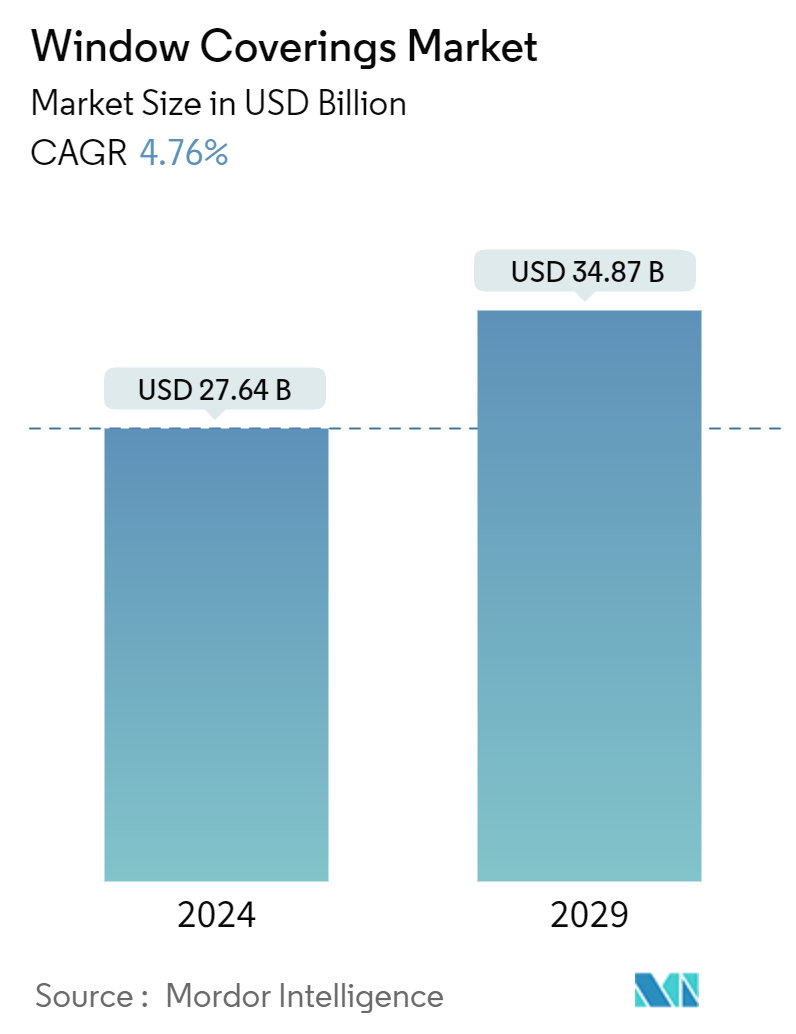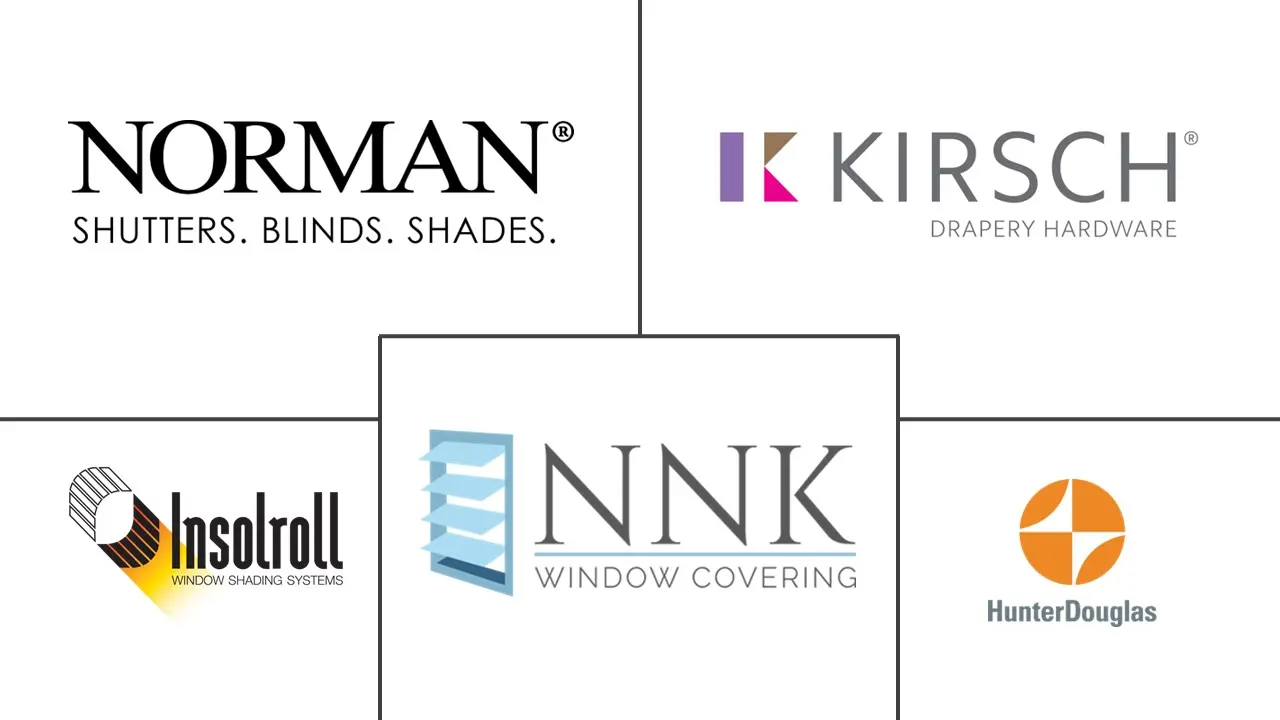Market Size of Window Coverings Industry

| Study Period | 2019 - 2029 |
| Market Size (2024) | USD 27.64 Billion |
| Market Size (2029) | USD 34.87 Billion |
| CAGR (2024 - 2029) | 4.76 % |
| Fastest Growing Market | Asia Pacific |
| Largest Market | North America |
Major Players
*Disclaimer: Major Players sorted in no particular order |
Window Coverings Market Analysis
The Window Coverings Market size is estimated at USD 27.64 billion in 2024, and is expected to reach USD 34.87 billion by 2029, growing at a CAGR of 4.76% during the forecast period (2024-2029).
Window coverings are materials used to cover windows inside a home. They serve various purposes, such as controlling light, enhancing privacy, improving energy efficiency, and adding aesthetic value to the room. Individuals and consumers' changing preference to adopt a Westernized culture with improved aesthetic appearance and modernized smart products further paves the way for the market's growth.
- As urbanization accelerates globally, homes are increasingly redesigned to incorporate communal and private spaces, embodying the essence of shared living. This trend is creating fresh opportunities for vendors in the market, spanning both residential and commercial sectors. Interior shutters, blinds, and shades dominate the market share among window coverings. The advantages of widely adopting energy-efficient window shades are substantial. The Attachments Energy Rating Council (AERC) highlights that while older homes and window systems usually contribute 25% of annual heating and cooling expenses, this figure can soar to 40%. Consequently, many homeowners find themselves overspending on heating and air conditioning. Research from the Department of Energy (DOE) underscores the significant energy-saving potential of window attachment products.
- As curtains are a traditional and long-standing part of home décor globally, European imports of natural fiber curtains depict expanded production capabilities. As over 50% of imports come from countries like the United Kingdom, France, and Germany, manufacturers are witnessing production ramp-ups aided by stabilized import activities.
- The adoption of smart window solutions brings home the interior experience with blinds and curtains, significantly improving comfort and convenience while always maintaining the right balance of natural and artificial light. The well-being of occupants and everyday conveniences are maximized. In February 2024, Marvin Launched a Smart Window and Door Line. These new Connected Home windows have sensors that close automatically in the rain.
- Moreover, with government initiatives to increase home building and renovations across numerous regions, the market for wall coverings is expected to grow. For instance, NHBC stated that South East and London had the highest number of NHBC housing registrations in 2023. They recorded 16.11 and 12.8 homes, respectively. Additionally, the government is planning for private housebuilders, housing associations, and councils to ramp up the annual construction to 300,000 a year by 2025.
- However, the industry has seen a variety of restrictions regarding corded window coverings. Over the past three decades, a department of the Canadian government called Health Canada has been striving to reduce the hazards related to corded blinds in Canada. This effort was motivated by the rising number of child fatalities from this risk. Governments in developing nations are anticipated to enact similar laws in the coming years.
Window Coverings Industry Segmentation
Window coverings are materials generally used to cover a window to manage sunlight, provide additional weatherproofing, ensure privacy or sometimes security, or for purely aesthetic purposes. Various window coverings include blinds, shades, shutters, and curtains. Window coverings can be static or dynamic. Static window coverings are fixed in place, while dynamic window coverings can change their status manually or automatically. Dynamic window coverings can control daylight and solar energy entering the building. They are effective in adapting to changing outdoor and indoor conditions.
The window coverings market is segmented by type (blinds [venetian, vertical, roller, and other blinds], shades [Roman, pleated, and roller], shutters, curtains, and other types), end-user vertical (residential and commercial), distribution channel (online and offline [departmental stores, specialists, DIY, and grocery stores]), and geography (North America, Europe, Asia-Pacific, Latin America, and Middle East and Africa). The market sizes and forecasts are provided in terms of value (USD) for all the above segments.
| By Type | |
| Blinds (Venetian , Vertical, Roller and others) | |
| Shades (Roman, Pleated and Roller) | |
| Shutters | |
| Curtains | |
| Other Types |
| By End-user Vertical | |
| Residential | |
| Commercial |
| By Distribution Channel | |
| Online | |
| Offline (Departmental Stores, Specialists, DIY, and Grocery Stores) |
| By Geography | |
| North America | |
| Europe | |
| Asia Pacific | |
| Latin America | |
| Middle East and Africa |
Window Coverings Market Size Summary
The window coverings market is poised for significant growth, driven by the increasing demand for energy-efficient solutions in both residential and commercial sectors. This market encompasses a variety of products, including solar screens, window blinds, and curtains and drapes, with window blinds being a popular choice after curtains. The trend towards urbanization and shared living spaces is creating new opportunities for market vendors, as homes are re-designed to accommodate communal and private areas. The evolution of window coverings from mere privacy solutions to essential home décor elements is also contributing to market expansion. The COVID-19 pandemic initially disrupted sales due to restrictions on home visits and logistics, but the subsequent rise in home renovations is expected to boost demand in the post-pandemic period.
The market is further influenced by the adoption of smart window solutions, which enhance comfort and convenience by balancing natural and artificial light. Government initiatives to increase home building and renovations, particularly in regions like the United Kingdom, are expected to drive market growth. However, the industry faces challenges with regulations concerning corded window coverings, prompting a shift towards safer alternatives. The Asia-Pacific region is experiencing rapid urbanization, with countries like China and South Korea leading the charge, supported by government policies and investments in smart home technologies. The market remains fragmented, with numerous players collaborating with designers to offer aesthetically pleasing and innovative products. Recent developments include the introduction of smart blinds and motorized solutions, catering to the growing demand for automated and sustainable window coverings.
Window Coverings Market Size - Table of Contents
-
1. MARKET DYNAMICS
-
1.1 Market Overview
-
1.2 Industry Attractiveness - Porter's Five Forces Analysis
-
1.2.1 Bargaining Power of Suppliers
-
1.2.2 Bargaining Power of Consumers
-
1.2.3 Threat of New Entrants
-
1.2.4 Threat of Substitute Products
-
1.2.5 Intensity of Competitive Rivalry
-
-
1.3 Impact of Key Macroeconomic Trends on the Market
-
-
2. MARKET SEGMENTATION
-
2.1 By Type
-
2.1.1 Blinds (Venetian , Vertical, Roller and others)
-
2.1.2 Shades (Roman, Pleated and Roller)
-
2.1.3 Shutters
-
2.1.4 Curtains
-
2.1.5 Other Types
-
-
2.2 By End-user Vertical
-
2.2.1 Residential
-
2.2.2 Commercial
-
-
2.3 By Distribution Channel
-
2.3.1 Online
-
2.3.2 Offline (Departmental Stores, Specialists, DIY, and Grocery Stores)
-
-
2.4 By Geography
-
2.4.1 North America
-
2.4.2 Europe
-
2.4.3 Asia Pacific
-
2.4.4 Latin America
-
2.4.5 Middle East and Africa
-
-
Window Coverings Market Size FAQs
How big is the Window Coverings Market?
The Window Coverings Market size is expected to reach USD 27.64 billion in 2024 and grow at a CAGR of 4.76% to reach USD 34.87 billion by 2029.
What is the current Window Coverings Market size?
In 2024, the Window Coverings Market size is expected to reach USD 27.64 billion.

